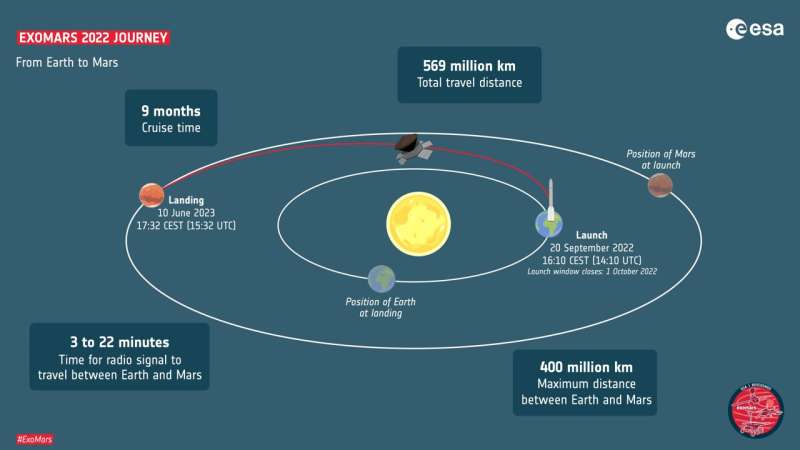"The rover is ready, and together with the recent drop test success for the parachutes, we are positive to be in time for the September launch date," says Pietro Baglioni, ESA's ExoMars rover team leader.
Only once every two years and for about ten days, celestial mechanics would allow the spacecraft to reach Mars from Earth in the shortest possible time—around nine months.
Rosalind now sits in an ultra-clean room at the Thales Alenia Space premises in Turin, Italy, right by its traveling companion, the Kazachok landing platform. Following a final review at the end of March, all the components of the spacecraft—rover, descent module, landing platform and carrier—will move to the launch site in Baikonur, Kazakhstan, to prepare for lift-off.
"Just before that last trip on Earth, we will upload the final version of the software that will allow the rover to scout Mars autonomously," explains Pietro.
First martian moves
Following the nerve-wracking descent to the surface of Mars, a long-awaited moment in the ExoMars mission will be when Rosalind leaves the landing platform and drives onto the martian soil for the first time. The egress from Kazachok is a carefully choreographed move that engineers are rehearsing on Earth.
The twin of ESA's Rosalind Franklin rover has successfully left the platform during recent tests in a Mars terrain simulator at the ALTEC premises in Turin.
While the driving during these exercises takes about 15 minutes, the whole process will last a few martian days. After landing, the rover will be busy for over a week unfolding its wheels and deploying the mast, among other checkouts.
"The egress is a long and crucial operation. We need to be gentle and run it in a very slow motion for extra safety," explains Andrea Merlo, ExoMars head of robotics from Thales Alenia Space.
The landing platform has two exit ramps: one at the front and another one at the back. Rosalind is designed to negotiate steep inclines on the ramps, but it is up to ground control on Earth to decide which is the safest way to drive off.
"Once the six wheels hit the martian surface, it will be the beginning of the story for this rover on Mars. We feel ready and are really looking forward to the real mission," says Andrea.

Amalia and Rosalind
The ExoMars twin rover, until now dryly known as the Ground Test Model, has a new name: Amalia. This test model borrows its name from Professor Amalia Ercoli Finzi, a renowned astrophysicist with broad experience in spaceflight dynamics.
Amalia was the first woman to graduate in aeronautical engineering in Italy, and besides serving as a scientific advisor for ESA and NASA, she designed the drill on Rosetta's lander Philae and strongly pushed for the development of the ExoMars drill already 20 years ago.
"I am flattered and honored to have this essential element of the ExoMars mission named after me. Mars is waiting for us," said Amalia after receiving the news.
Engineers are using the Amalia rover to recreate different scenarios and help them take decisions that will keep Rosalind safe in the challenging environment of Mars. The model is fully representative of what the rover will be able to do on the Red Planet.
"The fun has started. We will use Amalia to run risky operations, from driving around martian slopes seeking the best path for science operations to drilling and analyzing rocks," explains Andrea.
Amalia has so far demonstrated drilling soil samples down to 1.7 meters and operate all the instruments while sending scientific data to the Rover Operations Control Center (ROCC), the operational hub that will orchestrate the roaming of the European-built rover on Mars.
It takes a team
The effort to arrive at the starting line in time has been extraordinary, with double shifts and no time for breaks in 2021 amidst COVID-19 pandemic disruptions.
"The cooperation between European and Russian industry, the coordination between space agencies and the work of the technical teams have been remarkable," praises Pietro.
Teams have solved critical issues working in parallel, such as the parachute system and the descent module electronics, with enough margin for a launch in September 2022. Preparations for launch have started in Baikonur, and a dedicated support team is in place at ESOC center in Darmstadt, Germany.
The ESA-Roscosmos Trace Gas Orbiter is waiting for the arrival of ExoMars to the Red Planet. In addition to its own science mission, the orbiter relays data from NASA's Perseverance rover. Also on the martian surface since 2021 is China's Zhurong rover.
"It's not long to go before the European rover can finally join the other martian drivers in 2023 with a top class scientific laboratory on board," says Pietro.
The ESA-Roscosmos ExoMars 2022 mission will launch on a Proton-M rocket with a Breeze-M upper stage from Baikonur, Kazakhstan, in the 20 September—1 October 2022 launch window. A carrier module will transport the descent module with the Rosalind Franklin rover and Kazachok surface science platform inside, to Mars. Once landed safely in the Oxia Planum region of Mars on 10 June 2023, the rover will drive off the surface platform, seeking out geologically interesting sites to drill below the surface, to determine if life ever existed on our neighbor planet. The ExoMars program also includes the Trace Gas Orbiter, which has been orbiting Mars since 2016. As well as its own science mission, Trace Gas Orbiter will provide essential data relay services for the surface mission.



